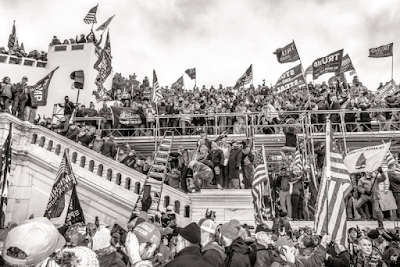February 18, 2023
Nate Gowdy – Town Hall Seattle
Nate Gowdy had previously photographed 30 Donald Trump rallies. He thought he was fully prepared for what should have been the grand finale, but the events that unfolded on January 6th, 2021, were more than anyone could have expected.
As the event transformed from protest to outright insurrection, Gowdy never stopped photographing. The result is his first monograph, Insurrection — a comprehensive yet intimate account of the events of that fateful day. The 150-page book moves readers through the day in timestamped, chronological order, bringing them a firsthand account of not just the attack on the U.S. Capitol, but what it was like to be a journalist on the front lines.
Juxtaposed are scenes of domestic terrorists kneeling and praying, posing for group photos, eating hotdogs, rampaging against the Capitol’s sworn protectors, and defiling the Inauguration Day stand, historically reserved for the stately pomp and circumstance of our representative government. On assignment for Rolling Stone, Gowdy was deemed “fake news” and assaulted twice for having professional cameras.
Gowdy joins us in the Wyncote NW Forum to share more about that historic day in January.
Nate Gowdy captures the complexities of American politics with striking clarity. Since chronicling Washington state’s fight for marriage equality in 2012, he has traveled the US to photograph pivotal events, figures, and movements across the political divide. His images have been featured in Rolling Stone, Mother Jones, PBS NewsHour, Thom Hartmann, CNN, and TIME, where his Bernie Sanders portrait graced the cover in 2016. As a co-founder of The American Superhero Project and co-author of Our Students, Their Stories, a book celebrating Seattle Public Schools’ LGBTQIA+ students, families, and staff, Gowdy is committed to elevating underrepresented voices. He serves as the official photographer for Seattle Pride, and his documentary fine art is represented at Monroe Gallery in Santa Fe.
Thursday, March 30, 2023, 7:30PM
The Wyncote NW Forum
1119 8th Ave (Entrance off Seneca St.)
Seattle, Washington 98101














